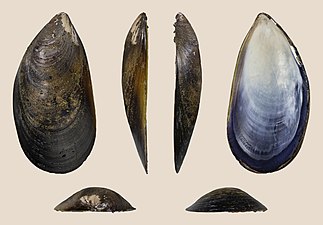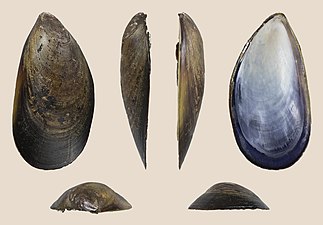Chilean mussel
| Chilean mussel | |
|---|---|

| |
| Scientific classification | |
| Domain: | Eukaryota |
| Kingdom: | Animalia |
| Phylum: | Mollusca |
| Class: | Bivalvia |
| Order: | Mytilida |
| Family: | Mytilidae |
| Genus: | Mytilus |
| Species: | M. platensis
|
| Binomial name | |
| Mytilus platensis d'Orbigny , 1842 | |
| Synonyms | |
| |
The Chilean mussel[1] or Chilean blue mussel[2] is a species of blue mussel native to the coasts of Chile from Biobío Region (37 ºS) to Cape Horn (55 ºS). Today genomic evidence confirmed that the native Chilean blue mussel is genetically distinct from the Northern Hemisphere M. edulis, M. galloprovincialis and M. trossulus[3] and also genetically different from Mytilus platensis,[4] the other species of smooth shelled mussel from South America.
Aquaculture
M. chilensis is under intensive aquaculture in Chile. From 2004 to 2008 the annual commercial harvest increased from 80,000 to 200,000 tonnes.[5] Following a decrease in 2009, the production was back at high level in 2010.[6] Over 45,000 tonnes of mussels were exported from Chile in 2008, 93% of them frozen. Some 74% of exports are to the EU, primarily Spain and France, and 15% to the United States.[5]
Systematics
Alcide d'Orbigny first described the species Mytilus platensis d'Orbigny, 1842,[7]. Species that was for many year erroneously confused with Mytilus chilensis described by Hipolito Hupé in 1854.[8] Nowadays most biodiversity data bases, such as the World Register of Marine Species [9] or the Integrated Taxonomic Information System [10] recognise Mytilus chilensis as a valid taxon in the Mytilus genus and different from Mytilus platensis. Mytilus chilensis is part of the worldwide
See also
References
- ^ Mytilus chilensis (Hupé, 1854) Sealifebase.org
- ^ S2CID 86038602. Archived from the originalon October 23, 2012. Retrieved 2009-01-22.
- doi:10.1111/eva.12553)
{{citation}}: CS1 maint: multiple names: authors list (link - )
- ^ a b Ríos, J. L. (2010):Mussels - May 2010, Chile Globefish.org.
- ^ Bivalves, February 2011 Globefish.org
- ^ d'Orbigny, A. (1836), Voyage dans l'Amérique méridionale (le Brésil, la république orientale de l'Uruguay, la république Argentine, la Patagonie, la république du Chili, la république de Bolivia, la république du Pérou), exécuté pendant les années 1826, 1827, 1828, 1829, 1830, 1831, 1832 et 1833, Vol. 5, Mollusques, Bertrand: Paris, pp. 49–184
- ^ Hupé, H. (1854), Moluscos de Chile. In C. Gay (Ed.), Atlas de la historia fisica y politica de Chile, Zoologia , Vol. 8, Thunot y Cia: Paris, pp. 1–407
- ^ Mytilus chilensis Hupé, 1854 www.marinespecies.org
- ^ Mytilus chilensis Hupé, 1854 www.itis.gov
- ^ ]


